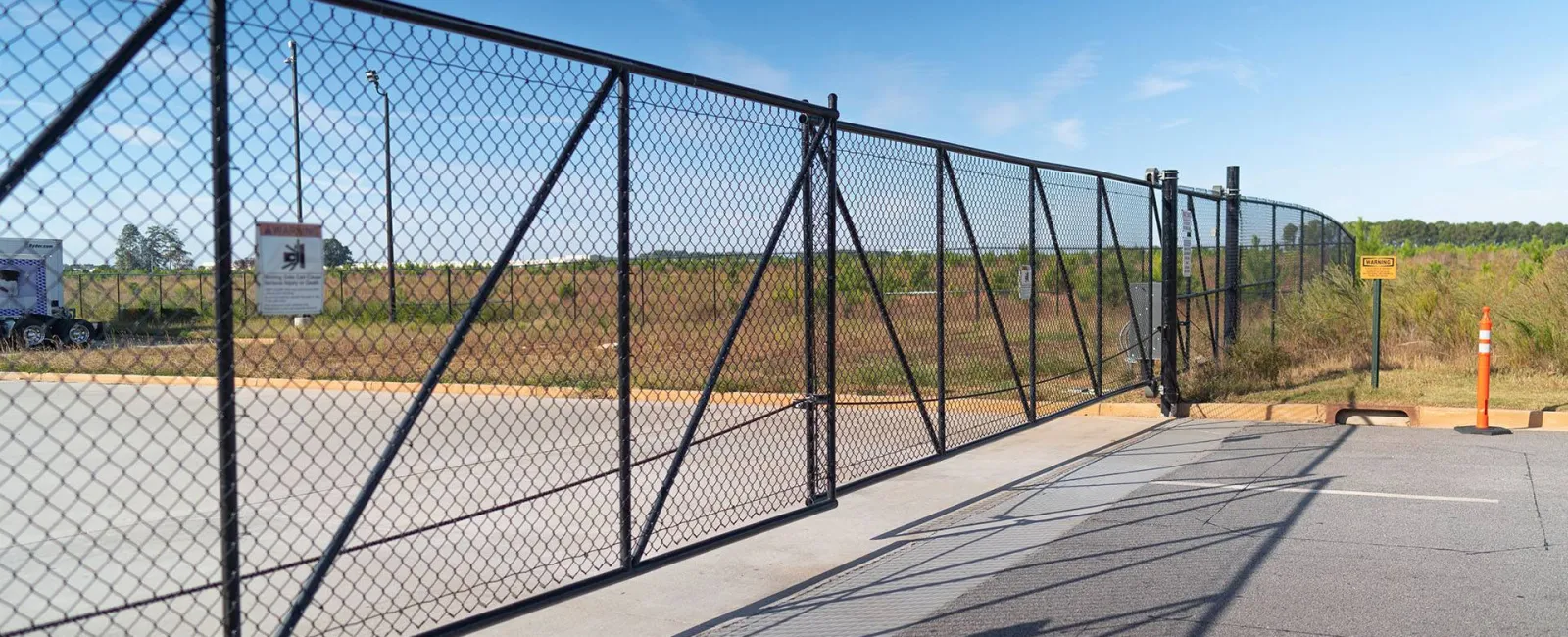Security is of utmost importance to property owners around the country and with rising crime in so many areas, it’s no wonder. From cameras and keyless card entry to security fencing and guards, keeping out unexpected visitors and ensuring employee, patron, and product safety is serious business.
However, when it comes to security fencing, there are several different choices and each has its own features and benefits. Whether you need to replace an old security fence or are moving into a new location, you should know the differences so you can get the best fit for your specific needs.
To assist with your research, we put together this guide on the different types of security fencing you can choose from. So, before you make that final decision, take a couple of minutes to read what we’ve put together.
Difference Between Security Fences and Regular Fences
It’s important to understand how security fences differ from regular fences. First off, where regular fences are generally used for decor or design integrity, security fences bring more durability and strength primarily for protection purposes. With that, security fences can also carry additional features like the option to install barbed wire or security cameras detecting movement. Most security fences are also considerably taller than regular fences.
What Type of Buildings Can Benefit From Security Fences?
Various commercial properties can benefit from security fences. Some examples include:
- Factories
- Storage Facilities
- Warehouses
- Prisons
- Industrial Buildings
- Government Buildings
- Schools
- Universities
- Theme Parks
Common Security Fencing Options
In short, there are seven top security fence choices for commercial properties:
- Welded Mesh Fencing
- Paladin Fencing
- Mini Mesh Chain Link Fence
- Anti-Crash or Anti-Ram Fencing
- Sleek Vertical Privacy Fence
- Palisade Fencing
- Electronic Security Gate
Welded Mesh Fencing
In general, mesh comes in a variety of styles and materials. The material ranges from minimal to extreme security depending on the material. Welded mesh fencing consists of thick wire welded together for maximum security.
The panels are placed vertically and horizontally across and welded together at the joints. The grid pattern of the small openings creates small openings no larger than an inch. This strong and durable fence makes cutting and climbing difficult — in most cases practically impossible.
Paladin Fencing

Part of the welded wire mesh family, paladin fences are uniquely constructed security fences that are both anti-cutting and climbing. The steel fencing panels have vertical and horizontal strands welded together with varied spacing. The “striped effect” across the fence reduces the ability to climb. The high-strength material makes cutting through using pliers or wire cutters difficult.
Aesthetically, this fence style offers a uniform design and various rust-resistant powder-coated colors. Paladin fences are commonly used at airports, sports facilities, and playgrounds.
Mini Mesh Chain Link Fencing
Standard chain link fences are considered easy to climb, especially for young kids. The spacing between the wireframe is easy to grab and leaves enough room for footholds.
With mini mesh chain link fences, the diameter of the openings ranges from ¼ to 1 inch. The tightly woven metal is thick and not easily cut, if at all. Mini mesh is a great alternative to standard chain link fencing by reducing climbing and offering more durability.
Anti-Crash or Anti-Ram Fencing

For certain areas or commercial properties, the surrounding barrier should withstand the impact of vehicles forcing entry. Industrial anti-crash fences differ from regular security fences because they require testing for crash-rated certification. In the US, the Department of State and the American Society for Testing and Materials (ASTM) developed the crash-test rating system qualifying these fences for different strength levels. These fences are ideal for areas requiring the highest level of security to protect from attacks or threats.
For reference, an anti-crash with an official crash-rated authorization can withstand vehicles from 3,000-16,000 pounds traveling at 30-50 miles per hour. These fences cause extreme damage to the vehicle thus protecting the property.
Sleek Privacy Fencing

Privacy fences can be both appealing and protective depending on the design. To increase privacy and security, fence panels are placed side by side leaving no visible space in between. With added height, this makes a vertical fence difficult to climb especially due to the sleek surface of the fencing material. The most common materials are pressure-coated wood, aluminum, and PVC.
Palisade Fencing

This effective security fencing style is both a deterrent visually and physically. The most notable feature of the palisade fencing is the sharp “D” and “W” shaped prongs on top of each post. The smooth surface of the metal post plus the rigid structure makes it difficult to hold onto.
Electronic Security Gates
In addition to a perimeter security fence, many choose to install a security gate or entry fence for added protection. These can come in various sizes and designs, from simple swing gates to more complex automated options with keyless access controls.
Fence Toppings for Added Security

Adding fence toppings reinforces security measures taken for protection. There are various types of topping styles depending on your needs.
Barbed Wire
Barbed wire is one of the most common additions to fences to prohibit climbing. The sharp points or edges are spaced along the steel fencing wire. The twisted design spreads the barbs evenly along the cable either diagonally or vertically. Barbed wire can be extremely harmful causing minor or severe injuries to the skin or deep tissue.
Flat Razor Wire
Also known as ribbon or barbed tape, razor wire is similar to barbed wire with sharp flattened edges instead of barbed points. Most razor wire is extremely durable and composed of steel. Typically, it can be standalone or added to a fence.
Unlike barbed wire, razor wire is sharper and tightly packed together. This design leaves no room for passage and can cut through clothes, skin, and other materials. Razor wire is considered more harmful to people or animals and should only be used for high-security purposes.
Wall Fence Spikes
Adding spikes to the top of a fence is another deterrent used to dissuade entry. These spike strips are placed along the top of the fence leaving no room for hands or feet. Visually, the spike protrudes from the top for an intimidating look.
Additional Considerations for Security Fencing
While the types of security fencing mentioned above are among the most popular options, other factors should also be taken into consideration when choosing a fence for your property.
Permits, Legal Requirements, & Property Lines
Before you can start the actual process of installing a security fence, you have to know your property boundaries as per the city/state. You may need to obtain permits or other legal documents before construction begins. Luckily, this is a process we can help with.
Height and Strength
The taller the fence, the more difficult it is for intruders to climb over. However, local regulations may define minimum or maximum height limits for fencing in your area. For example, the Georgia Department of Early Care and Learning recommends that playground fences be at least 4 feet tall. As for strength, some materials, such as steel and composite, offer superior strength compared to wood or aluminum.
Additional Features
Many security fences also offer additional features that include but are not limited to, easy installation of security cameras, movement sensors, and barbed wires. If you want to have more control over incoming personnel, enhancing your fence can help. You can also consult with us to get personalized recommendations catering to your needs.
Visibility and Aesthetics
Some commercial properties prefer a highly visible security fence as it acts as a deterrent to potential intruders. Others may want their security fence to completely block out any visibility so people cannot see through it. At the same time, some people prioritize aesthetics and opt for a fence that blends in with the surrounding landscape or matches their property design.
Maintenance and Longevity
Different materials require varying levels of maintenance, so it’s important to consider this when choosing a security fence. Additionally, some materials are more durable and long-lasting than others, which can affect your overall cost.
Budget
While some materials may be more expensive upfront, they may offer long-term cost savings due to their durability and low maintenance requirements. It’s important to weigh the initial costs against potential long-term expenses.
Conclusion
When it comes to the security of your commercial property, there are several choices. Your decision will depend greatly on what your security needs are. Do you need a tall, steel fence topped with razor wire or will a simple aluminum fence suit your needs?
If pricing is an important factor for you, you should start by looking at chain link or vinyl security fencing. If you need assistance, or would just like more information on the options discussed above, contact us and we’ll be happy to help.
First Fence of Georgia is an employee-owned company and we know that quality relationships are just as important as a quality security fence. Our four-step process is designed to foster that relationship to help ensure that you get the best experience possible. Let us help you secure what matters most to you.


